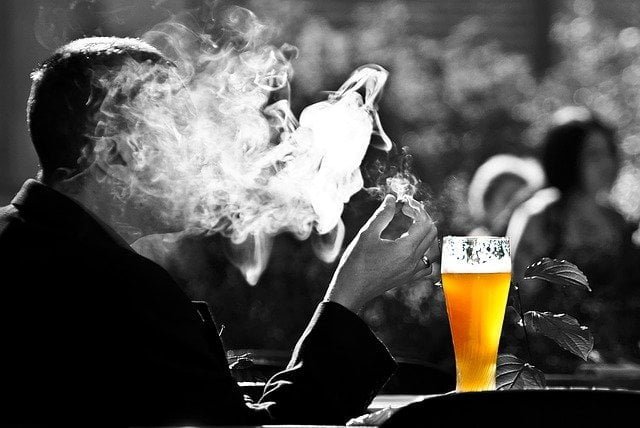
Tobacco and alcohol combine to increase cancer risk
Tobacco and alcohol combine to increase cancer risk
F For many people, smoking and drinking go hand in hand like eggs and bacon or sausage at a baseball game. But when it comes to cancer risk, Stephen Lynch, MD, an insertion and primary care physician at Phoenix Hospital, compares alcohol and tobacco to a more volatile combination. “It’s gasoline and sulfur,” he says. Tobacco and alcohol alone increase the risk of many types of cancer. Together, these two habits greatly increase the risk of cancer in the digestive tract: the lips, mouth, larynx, pharynx, throat, esophagus, and colon. “Smoking and drinking at the same time is known to significantly increase the risk of many cancers,” says Wissam Jaber, MD, director of interventional pulmonary medicine at Phoenix Hospital.
“You multiply your risk not just twice, but many times when you do both.” Wissam Jaber, Interventional Pulmonologist
Every cigarette damages the body in many ways. “Just one cigarette can increase the risk of cardiovascular disease,” says Dr. Jaber. “It raises blood pressure and cumulatively increases cancer risk over time.” Every time a smoker inhales a burning cigarette, a chemical chain reaction erupts that produces dozens of cancer-causing compounds. These compounds in cigarette smoke are inhaled through the lips, through the tongue and mouth, down the throat and into the lungs, causing inflammation throughout the body and exposing it to cancer-causing chemicals. Once in the lungs, the compounds in the smoke are absorbed into the bloodstream and spread the carcinogens to the rest of the body.
Smoking and drinking in numbers
- 20 percent of American adults, nearly 38 million people, are smokers.
- 70 percent of American smokers, more than 26 million people, also drink.
- 80 to 95 percent of alcoholics are smokers.
- 70 percent of alcoholics are heavy smokers (more than one can a day).
- 80 percent of throat and mouth cancers in men and 65 percent of throat and mouth cancers in women are associated with a combination of smoking and drinking.
- Sources: Gallup poll 2014; National Institute on Alcohol Abuse and Alcoholism
Smoking “can cause cancer almost anywhere in the body” and is linked to 90 percent of all lung cancers, according to the US Centers for Disease Control and Prevention. Smoking is the leading cause of preventable disease and death in the United States and contributes to more than 480,000 deaths each year. Tobacco smoke destroys not only DNA, but also cell proteins that repair DNA damage. Smoking also interferes with a process called metabolic detoxification, in which cells neutralize certain toxins and remove harmless byproducts from the body. “Tobacco is a no-brainer,” says Dr. Lynch. “Everyone gets it now. But alcohol, because it has some benefits in terms of lowering your risk of cardiovascular disease, people say it’s good for your health.”
Unlike cigarettes, not all drinks are harmful. Moderate amounts of alcohol can help reduce the risk of stroke and cardiovascular disease. “But that’s a fine line,” says Dr. Jaber. “When you exceed moderate use, you increase your risk of developing breast cancer, colon cancer, gastrointestinal cancer, and many other types of cancer.” The National Institutes of Health (NIH) and the American Heart Association define moderate use as no more than two drinks a day for men and one drink a day for women. Alcohol can increase your risk of developing cancer in several ways. It can cause inflammation in the liver and pancreas, which increases the risk of cancer in those organs. When it is metabolized, alcohol produces a substance called acetaldehyde, which can prevent cells from repairing DNA damage. “Alcohol is a carcinogen,” says Dr. Lynch. “There is no argument about that anymore.
What is a drink?
Alcohol increases the effect of tobacco in several ways, for example by increasing the production of certain enzymes that convert tobacco tar into carcinogens. Excessive alcohol intake can also suppress the immune system, and smoking and alcohol together can exacerbate the inflammation caused by both. “One plus one doesn’t equal two,” says Dr. Lynch. “There’s a lot of exponential synergy when you combine alcohol and smoking.” People who drink and smoke are 15 times more likely to develop cancer of the mouth and throat compared to non-alcoholic drinkers and non-smokers, according to the National Institutes of Health.
Some cancer patients may assume that they can also continue bad habits like smoking and drinking, because the damage has already been done. Dr. Jaber says it is wrong. “We try to intervene in both ways to reduce future risks and improve outcomes during cancer treatment by decreasing inflammation caused by drinking and smoking,” he says. Several studies have produced mixed results about the success of treating tobacco and alcohol addiction at the same time, but the National Institutes of Health recommends this approach. “Treatment of comorbid disorders remains a challenge,” says the National Institutes of Health. “However, the evidence suggests that combining therapies may be the most effective way to treat concurrent addiction.”



